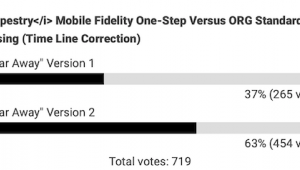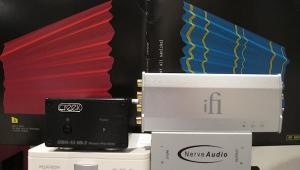Don't most media players offer non-destructive volume normalising? JRiver MC18 certainly does and I'm pretty sure foobar2000 does as well. In JRiver, analyze the tracks, enable Volume Leveling in DSP Studio and load the tracks up.
Primary tabs
Nine Cartridge Survey Produces Audible Results?

Each was recorded using one of ten different cartridges, nine of which were mounted on a VPI Traveler connected to a Graham Slee Era Gold Mk. V MM phono preamp.
The tenth is Ortofon’s $8499 Anna, which was mounted on the Continuum Cobra tonearm, Caliburn turntable combo connected to a Ypsilon MC-16 step transformer and VPS-100 phono preamp. That file is the “control” against which the others should be compared, except it will not be identified as such. None of the files, all created using a moderately priced HRT LineStreamer+ analog to digital converter, will be identified.
If you so choose, you can download the FLAC files and using a USB DAC, play them through your audio system. This will enable you to compare each cartridge’s rendering of the same song and your judgments without knowing which was which. Should you choose, you can vote for your favorite and in addition, in the comment section, we welcome your top three or top five favorites.
Listed from least expensive to most expensive, the nine moderately prices cartridges are:
Audio-Technica AT95E ($40)

Audio-Technica AT95SA ($149.95)
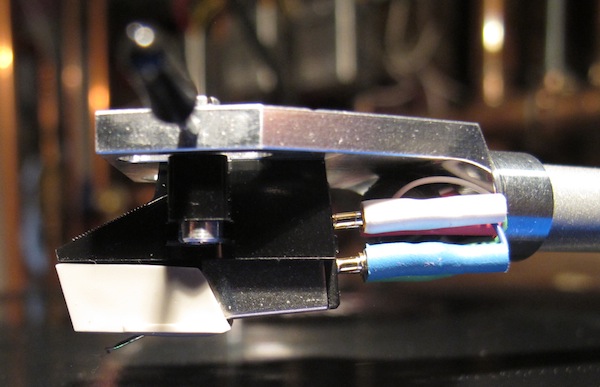
Audio-Technica AT7V ($159.99)

Grado Gold 1 ($220)
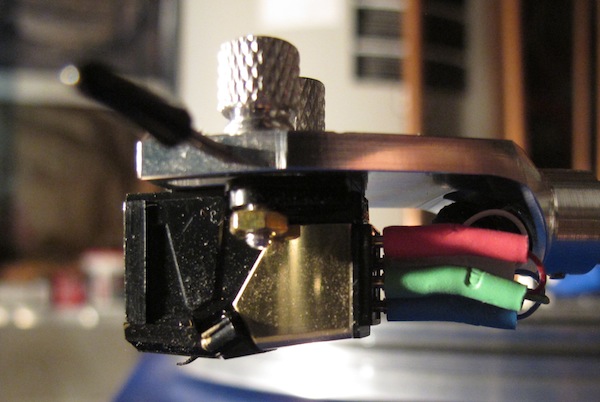
Ortofon 2M Bronze ($419)

Nagaoka MP-300 ($499)

Sumiko Blue Point EVO III ($499)
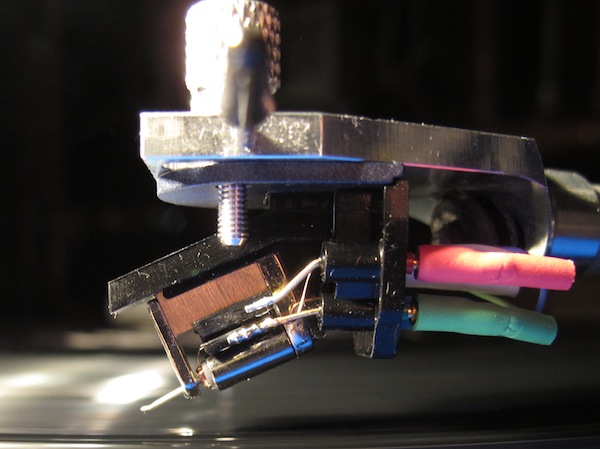
Ortofon 2M Black ($719)

Audio-Technica AT150ANV ($999)

All are moving magnet designs, with the exception of the Grado Gold 1, which is a moving iron and the Sumiko Blue Point EVO III, which is high output moving coil design.
While the cartridges are listed above in order of price, the files are not! The are organized randomly. Right click on PC or Control click on a Mac to download to your desktop.
Download Cartridge Test File #1 (68.8 MB)
Download Cartridge Test File #2 (73.7 MB)
Download Cartridge Test File #3 (71.8 MB)
Download Cartridge Test File #4 (77.7 MB)
Download Cartridge Test File #5 (71 MB)
Download Cartridge Test File #6 (73.7 MB)
Download Cartridge Test File #7 (74.5 MB)
Download Cartridge Test File #8 (71 MB)
Download Cartridge Test File #9 (75.6 MB)
Download Cartridge Test File #10 (71.6 MB)
In a few weeks we will reveal their identities. In addition, because I’m sure some if not many of you will not take the time to download and listen, I will review each from my perspective and include the specs (etc.).
In addition, if you like the track (I didn’t get sick of it and I listened dozens of times), HDTracks has generously given us a discount download code if you are so digitally inclined. Also note that the album is available on CD and SACD as well as on vinyl.
Special HDTracks.com offer: Now through August 31st receive a 20% download discount on Myra Taylor's "My Night To Dream". Choose either the 88.2/24 bit or the 44.1k/16 bit version or both. Use promo code "compare20"
Choose your favorite sounding Cartridge Test File below:

- Log in or register to post comments


Hey, thanks for this post.
I'd been ready to possibly never get around to comparing the files due to the volume mismatch. I'll give this a try and try and post my own votes this weekend-
There's much about the JRiver software I've not yet taken the time to explore, including the DSP Studio.

After carefully adjusting the volumes in Sound Forge Pro 10 so that the perceived sound pressure levels were the same across all files, my favourite cartridge is No. 2.
I should state that I only listen to classical music on my main system and on vinyl, so I do not consider myself anything approaching an expert, knowledgeable or even experienced listener when it comes to jazz. It would have been a lot more meaningful, educational (and possibly easier) for me to hear these cartridges using a classical record with which I was familiar and which preferably presented a significant technical and tracking challenge, particularly on inner grooves. These are aspects that this test does not address and I have found that sometimes quite cheap cartridges can sound very nice, but throw a technically challenging classical LP at them and they completely fall apart. This is often what separates expensive cartridges from cheaper ones.
Nevertheless, I choose No. 2 because (i) it was the only one I heard where the critical micro dynamics were preserved - the others sounded papery and "flat" by comparison in varying degrees (ii) it had the smoothest sound and flattest sounding frequency response (iii) it was devoid of what I call vinyl "hash", which is a low-level cloudiness, graininess and lifting of the upper range frequency response that I often hear with cartridges that do not have sophisticated stylus profiles or which do not track as well as the turntable and arm combination allow (iv) the imaging is absolutely super-rock solid - just like I would have expected to hear on the original master tape and (v) No. 2 subjectively was the excerpt that I wanted to keep coming back to listen to over and over again without growing tired of it. It just had this "live" feel and juiciness about it that I did not hear in the others. With the others I was losing interest and interestingly this remained the case even if I made the other tracks louder and No. 2 softer.
I will be interested know which cartridge is which, since if I picked a cheap one as my favourite, I suppose I can end up both happy and embarrassed - happy because whatever I chose satisfies my old ears very much for jazz and would cost vastly less than what I would be paying for a car! But as I say, a proper test for a cartridge as far as I am concerned would require listening to around 20 different classical LPs and certainly testing their tracking capabilities - especially on inner grooves. That said, I also feel that cartridge No. 2 was tracking the best here as well.
Thanks for making this test available. As I say, I am happy to be severely embarrassed if it means I learn something and / or save money!

My pick is #7. What stands out to me about this one is the separation between instruments and voices. Everything just sounds more articulate and there is a greater sense of depth.
My system is pretty modest by Stereophile standards, and I've voiced it to sound pleasing to my ears, not for maximum resolution, so I'm not surprised that Michael's reference does not jump out at me. No shame in that as far as I'm concerned.
That said, here are my brief impressions of each cut:
#1 Good depth and dimensionality, but midrange seems slightly sucked out.
#2 Tonal balance seems bright. Forward sounding.
#3 Good tonal balance, but not as much dimensionality.
#4 Laid back tonal balance, background seems less "black."
#5 Somewhat muddy sounding. Seems lacking in resolution and separation between instruments.
#6 Nice, but perspective seems a bit distant.
#7 My favorite. Nice tonal balance. Excellent separation between instruments and voices. Bass seems slightly lightweight compared to other cuts, but I am guessing that it is more accurate.
#8 Laid back sound. Slightly opaque.
#9 Nice tonal balance. Good separation. Smooth sound.
#10 Very good tonal balance. Smooth.
Okay. I am prepared to be made a fool of. For all I know I picked the AT95E as the winner. None of these sound bad to me. Thanks for doing this Mr. Fremer. It's been a fun exercise, and I look forward to seeing which cart is which. Next time, in addition to the volume issue, it might be interesting to hear an inner groove cut to see which cart is handling those difficult to track sections better.
[Edit: I changed my pick to #1...I had been going back and forth between #7 and #1. See comment below.]

First Place; no.7
Second Place: no.2 (but not as refined, not as organized, very hi surface noise)

One of the hazards of doing the level-matching is that you learn a bit too much about the samples. One of them has a conspicuously lower measurable noise floor after everything is matched - it must be the Caliburn. It's going to be difficult to ignore that assumption while listening again.

One thing that's very clear to me after listening to all the files is that the digital recording, while preserving plenty of the essential character of each cartridge, is no substitute at all for the real thing - "live" replay direct from the turntable. I've experienced this kind of thing before, when I've done my own digital "shootout" files.
I reckon I would probably pick my SP10 (my 2nd turntable) with a Denon DL-103 ahead of all 10 of these digital versions. I never got the impression of "real" vinyl magic in the files, even though they're really good files.

To my ears, and in my system, cartridges #2, #3 and #6 sound the funniest (in a good sense). #2 is also the more accomplished (resolution, tonality, timing, imaging, micro dynamics), and gets my vote (although #7 has more depth and refinement)...

Downloaded all and will start the final listening tests tomorrow in Sound Forge. Made some notes today for each in terms of output level, surface noise, pre-echo, and then tonality of the piano, sax and voices. I also will try tomorrow to make note of the ability to pick out individual singers.
Fearful that my winning choice will expose my tin ears. ;>o

I do lots of digital transfers, still using the Alesis Masterlink and very happy with it.
I am curious to know your process, what software you used and why you chose the HRT Linestreamer+ instead of a reference level ADC?

I preferred 4, 5, 6, and 8(my fav)
concentrated on output vs surface noise, pre-echo, the combined voices and the smoothness of the piano and the sax.

Mike.
Why can't I download your files? I live in the UK so is there a filter prohibiting use outside North America. Be a shame if that is the case.
Pete.

I downloaded the largest file from South Korea, although it did take 2 hours to do so! 

I want to change my vote to #1. Best transient speed coupled with articulate sound and depth. Midrange could be richer perhaps, but I have a feeling #1 is telling the truth, while #7 has a slightly more romantic sound. I think #1 is the Anna on Mikey's rig.
Okay, I'm done. (Although if I change my vote enough times, I am bound to be right eventually).

Thank you so much for this. It was a blast going through these files, and no, I too did not get tired of the song (love it). I'm unable to listen to these through my system because my power amp died a couple years back, but regardless of that, the place I'm currently living requires me to listen at a volume lower than that necessary to really critically evaluate these sound files.
These days, 90% of my listening is through my Grado headphones. I do quite a few needledrops with my Rega P5/Dynavector 17D3 combo through my PS Audio GCPH Preamp and Duet converter and I believe I've gained some skill at it. Upon listening (through my headphones), I found that the difference between these carts was dramatic. For me, #7 was the best and #4 the least impressive.
I certainly hope you can do another of these in the near future, with carts priced in the range of 1 to 2 thousand, which seems to be the sweet spot for price vs. performance.

To me, it sounded the most real. It also seemed the best at microdynamics. When singers or instrumentalists leaned into a note, it seemed the most fluid, going with the push more fully.

I have to say I was surprised by the poll results since I thought the best sound was clearly from #1 and it trailed significantly by others in the poll that were my least favorite! Go figure.
#1 has the lightning fast transients coupled with an extended HF that I enjoy with LOMC and step up transformers. But I do know from experience, this does not always come across as strongly in a digital recording as it does "live" so I could be wrong (wouldn't be the first time)
My follow up choice would be #10 - another that hasn't received much love in the poll.

I like the 3, 5, 7 and 10 and I think one of this could be the Anna. I have followed the saxophone and, on this tracks it was, for me, the most natural. Number 3 have the best slam and the most pronunced highs with air around them, and is the most rithmic track.
I hardly wait for the official results revealed by Mr. Farmer.
Best regards!

The only thing this exersize proved to me is, I no longer need to lust after Mikey's vinly rig.
I would think that a 6 figure vinyl set up would stand out like a sore thumb. It doesn't. I think it's #7, but I wouldn't bet money on it.
Doc

I'm sure all these cartridges sound better live than what we are hearing. These are all being digitized after all and through a pretty inexpensive AD converter at that.

Which I hear right before the music starts, I believe that this is the track using transformer and thus is the Anna. Other than that, I like most people who tried this are amazed that the differences are so indiscernable. Makes one wonder about their hifi choices.

... really make it hard to compare :(
It's great to have these files available, they can really help to learn how each of these carts can sound (at least it provides an approximation), but without giving them an equal fair treatment (average gain in the resulting file, and all the issues related to the way the ADC is working and coping at different outputs from the carts) the poll results will be very deceiving... and this without going into how much it can (and will) vary between each complete audio system where these will be played... file A can sound completely different on different systems where the speakers, headphones, amplifiers, DA converters, room acoustics and so on and so on will make a BIG difference in perceived sound characteristics of each cart here...
So there are a lot of factors contributing to make this fail and we can't really do much about it without working on it as if it were the next big space endeavour, we should all try to keep it simple, not quite scientific, but certainly fun and I thank Michael for taking the time to do this!

Here are my rankings. I thought the differences showed up most in clarity, micro dynamics and the ability to separate out the instruments when it got a bit more complex. I ggenerally separated them into 3 groups Within the groups it was more difficult and seemed a matter of choice in some cases. I will be very bummed if I chose wrong, as I just bought the Anna
9, 1, 2, 3, 10, 7, 8, 6, 5, 4

Thanks to Michael Fremer for taking the time to create this survey. I normalized the files with Sound Forge Pro 10 and playing through a Dragonfly dac #7 was top of my list. I suppose if this is done again it would be best to normalize the files from the get-go. Nonetheless, a fun and instructive experiment!

Excellent idea for a test!
First of all - great sounding track. Great tune and obviously a great recording - that's why all the samples sound great.
As for volume matching - it's easy if you use Foobar as a media player. Just load all the tracks, select them, right click and then select ReplayGain>scan per-file trrack gain. Then select 'update tags' with the settings. This scans the average (RMS) levels of each file, and does very accurate level matching when playing back, without adding any compression. Then enable ReplayGain in Preferences>Playback. Select source mode "track", and "apply gain". I use a Schiit Bifrost as a DAC.
I liked 10, 3, 1, and 7, which was definitely brighter, which sounded nice on some things, not as nice on other things. I liked 5 & 6 the least. Whichever one was the AT95E, this test shows that even a cheap cartridge, setup properly on a decent turntable with a good preamp, can sound great, with a great sounding record (the most important thing).

Well I tried this with the replaygain feature from JRiver Media Center 18, and it seems to work pretty well...
So far tracks 2 and 9 sound best to me.
Tracks 1 and 3 are ok almost up there with the two best carts...
Tracks 4, 5, 6, and 8 are somewhere in the middle...
Tracks 7 and 10 sound worst.
I'm doing this on the PC with Sennheiser HD215 headphones... not quite "audiophile grade" :(
Might try it again with the Sennheiser HD600 that are a little better...
Anyway, they all sound quite good... the only cart that really became annoying (too much top end) was the number 7.

I don't normalize I will apply gain set peaks to come in at -1dbs then I will analyze the spectrum. There should be some clues there seeing the frequency response of the cart since that is the variable.
Micheal did you do any post processing of your recordings? DC offset, subsonic filter and or click repair etc?

